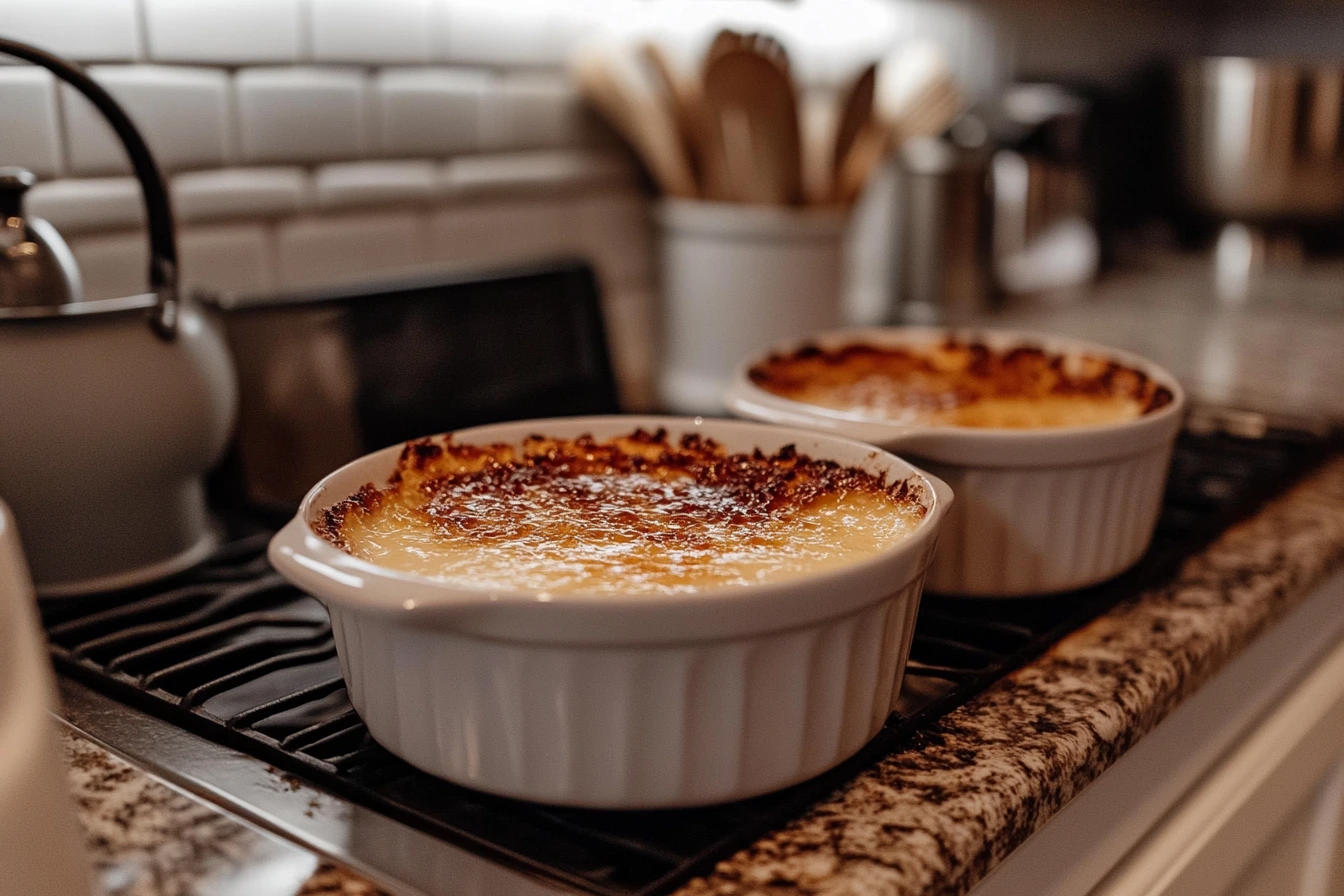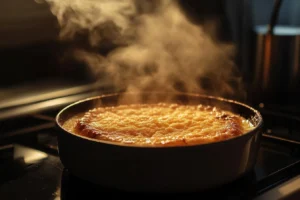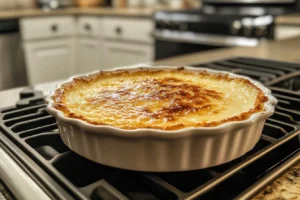Introduction and Overview
Introduction to Crème Brûlée
Crème brûlée is a timeless French dessert that has captivated food lovers worldwide. Known for its creamy custard base and perfectly caramelized sugar topping, it combines simplicity and sophistication in one elegant dish. Although often associated with fine dining, this dessert is equally delightful when prepared at home.
cream to use for the perfect result, check out this detailed guide on what type of cream is best for crème brûlée.
- It has a rich texture that melts in your mouth.
- The signature crunch of the caramelized sugar crust adds a delightful contrast.
In addition, crème brûlée is celebrated for its versatility. From classic vanilla to innovative flavors like chocolate, coffee, and citrus, it can be tailored to suit any palate. Whether you enjoy it at an upscale restaurant or in the comfort of your kitchen, crème brûlée is sure to impress.
Brief History of Crème Brûlée
The origins of crème brûlée can be traced back to 17th-century France. Notably, the dessert was first documented in a 1691 cookbook written by François Massialot, a renowned French chef who served royalty and aristocrats. At the time, his work highlighted the dish’s elegance and its association with the upper class. As such, crème brûlée quickly became a symbol of sophistication and culinary refinement. Since then, it has maintained its status as a timeless, luxurious dessert enjoyed around the world.
- The term crème brûlée translates to “burnt cream” in French.
- Its caramelized sugar crust, therefore, gives it both its name and appeal.
Interestingly, there are debates about its exact origins, as similar desserts existed across England and Spain during the same period. For example:
- In Spain, a dish called “crema catalana” featured a similar custard topped with caramelized sugar.
- In England, a dessert known as “burnt cream” shared similar characteristics.
However, it was France that popularized the dish, turning it into the iconic dessert we know today. Over centuries, chefs refined its preparation, and it became a staple in haute cuisine.
Key Ingredients in Crème Brûlée
The Main Ingredients of Crème Brûlée
At its core, crème brûlée is made of a few simple ingredients that, when combined thoughtfully, work together to create its rich and velvety texture. First and foremost, heavy cream provides the luxurious base, while egg yolks add structure and silkiness. In addition, granulated sugar sweetens the custard and forms the crisp, caramelized topping. Meanwhile, vanilla extract or real vanilla beans infuse the dessert with its signature aromatic flavor. Together, these ingredients transform into a decadent treat that is both elegant and indulgent.
- Heavy cream: Provides the luxurious creaminess essential to the custard.
- Egg yolks: Contribute to the smooth texture and help the custard set properly.
- Granulated sugar: Sweetens the custard and forms the iconic caramelized topping.
- Vanilla extract: Enhances the overall flavor profile of the dessert.
- Optional pinch of salt: Balances sweetness and intensifies flavors.
The secret to a perfect crème brûlée lies in the quality of ingredients. For example:
- Use high-fat heavy cream for a smoother consistency.
- Fresh egg yolks ensure a silky custard texture.
- Opt for real vanilla beans instead of artificial flavoring to elevate the dish.
The Importance of High-Quality Ingredients
When making crème brûlée, the quality of ingredients directly impacts the final result. Therefore, investing in the best ingredients ensures your dessert reaches its full potential.
-
Heavy Cream:
- Choose cream with a high-fat content (35% or more).
- Low-fat cream may result in a runny or less rich custard.
-
Egg Yolks:
- Fresh, organic eggs provide a richer texture.
- Avoid egg whites, as they may alter the custard’s consistency.
-
Vanilla Beans or Extract:
- Vanilla beans add a natural, intense flavor.
- If unavailable, high-quality pure vanilla extract works as a substitute.
-
Sugar:
- Fine granulated sugar melts evenly, creating the signature caramelized topping.
By prioritizing these key components, you can ensure your crème brûlée achieves its iconic balance of rich custard and crispy caramel every time.
The Science of Crème Brûlée
How the Ingredients Work Together
The magic of crème brûlée lies in the perfect balance between its custard base and caramelized topping. Understanding the science behind the ingredients helps ensure a flawless result.
-
Heavy Cream and Egg Yolks
- Heavy cream provides fat, giving the custard its smooth, rich texture.
- Egg yolks act as a binder when gently heated, thickening the mixture to achieve a silky consistency.
- Science tip: Avoid overheating the mixture. If the yolks are cooked too quickly, they will curdle, resulting in a grainy texture.
-
Sugar in Two Roles
- In the custard: Sugar dissolves to add sweetness.
- On the surface: Granulated sugar melts and caramelizes to form the signature crisp crust.
- Science tip: Caramelization occurs around 320°F–350°F, transforming sugar into a golden, brittle layer.
-
Vanilla Extract or Beans
- Vanilla provides the aromatic profile that complements the creamy custard.
- Using real vanilla beans adds depth of flavor and tiny black flecks for a visual touch.
Together, these ingredients undergo a gentle cooking process. Baking the custard in a water bath helps maintain even heat, preventing overcooking while ensuring a perfectly smooth texture.
Caramelization: The Key to the Perfect Topping
The caramelized sugar topping is what makes crème brûlée visually stunning and irresistibly delicious. Here’s how to get it right:
-
Choosing the Right Sugar
- Use fine granulated sugar for even melting. Coarser sugars take longer and may burn unevenly.
-
Techniques for Caramelization
- Kitchen Torch: Provides precise heat control and ensures an even, golden finish.
- Broiler Method: Place the custards under a hot oven broiler for a few minutes, watching carefully to avoid burning.
-
Steps to Caramelize the Sugar
- Let the custard cool completely before adding sugar.
- Sprinkle a thin, even layer of sugar on top of the custard.
- Heat the sugar evenly until it melts and turns golden brown.
- Allow it to cool for a minute to form a crisp, brittle layer.
Pro tip: Rotate the dish while torching to avoid burnt spots. The sugar should melt evenly and harden into a glassy crust that cracks beautifully when tapped.
Variations and Customization
Popular Flavor Variations of Crème Brûlée
While the classic vanilla crème brûlée is beloved worldwide, there are countless ways to customize it with unique flavors. Adding new ingredients can transform this traditional dessert into something truly special.
-
Chocolate Crème Brûlée
- Add melted dark chocolate to the custard mixture for a rich, decadent twist.
- Garnish with chocolate shavings or a dusting of cocoa powder.
-
Coffee or Espresso Crème Brûlée
- Infuse the cream with strong espresso or instant coffee for a bold, aromatic flavor.
- Pair with a sprinkle of cocoa nibs for added texture.
-
Citrus Infusion
- Zest from lemons, oranges, or limes can brighten up the custard’s flavor.
- Serve with candied citrus peel for an elegant touch.
-
Fruit-Infused Crème Brûlée
- Mix purees like raspberry, strawberry, or mango into the custard base.
- Add fresh fruit as a garnish for a refreshing contrast.
-
Alcohol-Enhanced Versions
- Flavors like rum, brandy, or Grand Marnier can add depth to the custard.
- Use sparingly to maintain the dessert’s delicate balance.
By experimenting with these variations, you can tailor crème brûlée to suit different occasions, seasons, and taste preferences.
Garnishes and Presentation Ideas
Presentation is key to elevating crème brûlée into a visually stunning dessert. Simple, thoughtful garnishes can make a big impact without overpowering the dish’s delicate flavor.
-
Classic Garnishes:
- Fresh berries (e.g., raspberries, blueberries, strawberries).
- A dollop of lightly sweetened whipped cream.
- Chocolate shavings or cocoa powder.
-
Elegant Additions:
- Edible flowers for a sophisticated touch.
- Mint leaves for a burst of color.
- Drizzles of caramel or chocolate sauce around the custard.
-
Creative Ideas:
- Add a small sprinkle of sea salt on the caramelized crust for a sweet-salty contrast.
- Use nut brittle or toasted nuts for an added crunch.
The key is to keep garnishes light and complementary, ensuring they don’t overwhelm the dessert’s signature flavors.
Tips and Techniques
Step-by-Step Process for Baking the Perfect Crème Brûlée
Mastering crème brûlée requires precision and attention to detail. By following these steps, you can achieve a flawless, silky custard every time:
1. Preparation of Ingredients
- Gather heavy cream, egg yolks, sugar, and vanilla extract.
- Use high-quality vanilla beans for the best flavor.
- Preheat the oven to 320°F (160°C) for consistent, gentle cooking.
2. Making the Custard Base
- Heat the heavy cream gently in a saucepan until just below boiling (small bubbles around the edges).
- Whisk the egg yolks and sugar in a separate bowl until pale and smooth.
- Gradually pour the hot cream into the egg mixture while whisking constantly to avoid curdling.
- Stir in the vanilla extract or scraped vanilla bean seeds.
Pro Tip: Strain the custard through a fine-mesh sieve to remove any curdled bits and ensure a perfectly smooth texture.
3. Preparing the Water Bath
- Pour the custard mixture into small ramekins (oven-safe dishes).
- Place the ramekins in a baking dish and carefully pour hot water into the dish, filling halfway up the sides of the ramekins.
- This water bath method allows for even cooking and prevents the custard from overheating.
4. Baking the Custard
- Bake for 35–45 minutes, depending on your oven.
- The custard should be set around the edges but slightly jiggly in the center.
- Remove the ramekins from the water bath and let them cool to room temperature.
Pro Tip: Overbaking will cause the custard to become rubbery. Keep a close eye on it!
5. Chilling and Final Touch
- Refrigerate the custards for at least 2–4 hours to allow them to set fully.
- Before serving, sprinkle a thin layer of sugar evenly over the surface and caramelize it with a kitchen torch or under a broiler.
- Let the sugar cool for a minute to harden into a crisp, golden crust.
Troubleshooting Common Issues
Even experienced bakers encounter challenges when making crème brûlée. Here are solutions to common problems:
-
Custard Isn’t Setting Properly
- Cause: The custard may have been underbaked.
- Solution: Bake for a few extra minutes and ensure the oven temperature is accurate.
-
Custard Has a Grainy Texture
- Cause: The eggs cooked too quickly, causing curdling.
- Solution: Use a water bath and bake at a low temperature. Always temper the eggs with the hot cream gradually.
-
Sugar Topping Won’t Caramelize
- Cause: The sugar layer may be too thick or uneven.
- Solution: Use a thin, even layer of fine sugar and apply consistent heat with a torch.
-
Sugar Burns Too Quickly
- Cause: Excessive heat or torching too close to the surface.
- Solution: Hold the torch a few inches away and rotate it evenly.
By following these tips, you can avoid common pitfalls and create a perfect crème brûlée every time.
Pairing and Serving
The Perfect Beverage Pairings for Crème Brûlée
Pairing crème brûlée with the right beverage can enhance its delicate flavors and create a memorable dessert experience. Here are some excellent options:
-
Dark Roast Coffee or Espresso
- The bitterness of coffee perfectly contrasts with the custard’s sweetness.
- A small shot of espresso can balance the dessert without overwhelming it.
-
Dessert Wines
- Sauternes: A sweet French wine with notes of honey and apricot complements the richness of crème brûlée.
- Muscat: Its floral, fruity flavor pairs beautifully with the creamy custard.
-
Champagne or Sparkling Wine
- A glass of crisp, dry champagne adds lightness to balance the dessert’s richness.
- Its bubbles refresh the palate between bites.
-
Tea Pairings
- Delicate teas like jasmine or chamomile work well without overpowering the dessert.
- For a bolder choice, pair with a robust Earl Grey tea.
These pairings enhance the flavor profile of crème brûlée, making it an indulgent treat for any occasion.
Occasions for Serving Crème Brûlée
Crème brûlée is a versatile dessert perfect for a variety of settings. Its sophisticated appearance and rich flavor make it ideal for:
-
Fine Dining and Special Occasions
- Serve it as the grand finale of an elegant dinner party or holiday meal.
-
Romantic Dinners
- Its delicate texture and luxurious flavor make it a romantic choice for Valentine’s Day or anniversaries.
-
Casual Gatherings
- Mini crème brûlées in small ramekins are perfect for buffet-style events or family gatherings.
-
Seasonal Celebrations
- Add seasonal twists (e.g., pumpkin crème brûlée for fall) to suit specific festivities.
No matter the occasion, crème brûlée adds a touch of elegance and indulgence to any dessert spread.
FAQs (People Also Ask Section)
FAQs About Crème Brûlée
To help address common questions, here are detailed answers to some of the most frequently asked queries about crème brûlée. By understanding these insights, you can troubleshoot challenges, refine your technique, and achieve flawless results every time. Whether you’re a beginner or an experienced baker, these answers will guide you through the process of mastering this elegant dessert.
1. What does crème brûlée taste like?
Crème brûlée boasts a rich, creamy, and smooth custard base topped with a sweet, caramelized sugar layer. Not only does the custard feature subtle vanilla notes, but it also provides a delicate, melt-in-your-mouth experience that feels indulgent yet light. Meanwhile, the crisp caramelized sugar offers a satisfying contrast in texture, with its slightly toasted, sugary flavor enhancing the overall dish. Together, these elements create a dessert that is both refined and irresistibly satisfying.
2. Is crème brûlée hard to make?
While crème brûlée may look fancy, it is relatively simple to make with the right techniques. The recipe involves basic steps: preparing the custard, baking it gently in a water bath, and caramelizing sugar on top. However, precision with temperature and ingredients is essential to avoid curdling or burning.
3. What is the difference between flan and crème brûlée?
Both desserts feature a custard base, but they differ in texture and presentation:
- Flan: A soft custard with a liquid caramel sauce on top. It’s baked upside down, then flipped before serving.
- Crème Brûlée: A firmer custard topped with a hard, caramelized sugar crust achieved by torching or broiling.
4. Why is my crème brûlée not setting properly?
If your custard isn’t setting, the likely causes are:
- Underbaking: Ensure it’s baked long enough. The edges should be set, but the center can remain slightly jiggly.
- High oven temperature: Bake at a low, consistent heat to avoid uneven cooking.
- Incorrect ingredient ratios: Use the precise number of egg yolks and cream.
5. Can you make crème brûlée ahead of time?
Yes, crème brûlée is an ideal make-ahead dessert:
- Prepare and bake the custards up to 2 days in advance.
- Store them covered in the refrigerator.
- Caramelize the sugar just before serving to maintain the signature crisp topping.
6. Do you need a kitchen torch to caramelize crème brûlée?
A kitchen torch is the preferred tool for even, precise caramelization. However, you can use the broiler method as an alternative:
- Place the ramekins under a preheated broiler for 2–3 minutes. Watch carefully to avoid burning.
- Rotate the dishes for an even golden crust.
By addressing these common questions, you’ll feel more confident when preparing this timeless dessert at home. Over time, with patience and practice, your crème brûlée will turn out perfect every single time. As a result, you can impress family and friends with a dessert that combines elegance, simplicity, and indulgence.
Conclusion
The Timeless Appeal of Crème Brûlée
In conclusion, crème brûlée remains a beloved dessert worldwide, celebrated for its elegance, simplicity, and indulgent flavors. Its combination of a silky custard base and crisp caramelized sugar crust creates a textural harmony that few desserts can rival.
The use of simple ingredients heavy cream, egg yolks, sugar, and vanilla proves that culinary excellence doesn’t require complexity. Whether you stick to the classic recipe or experiment with innovative flavors like chocolate, coffee, or citrus, this dessert is endlessly versatile.
For a complete comparison, you can explore this in-depth explanation of the difference between crème brûlée and custard.



